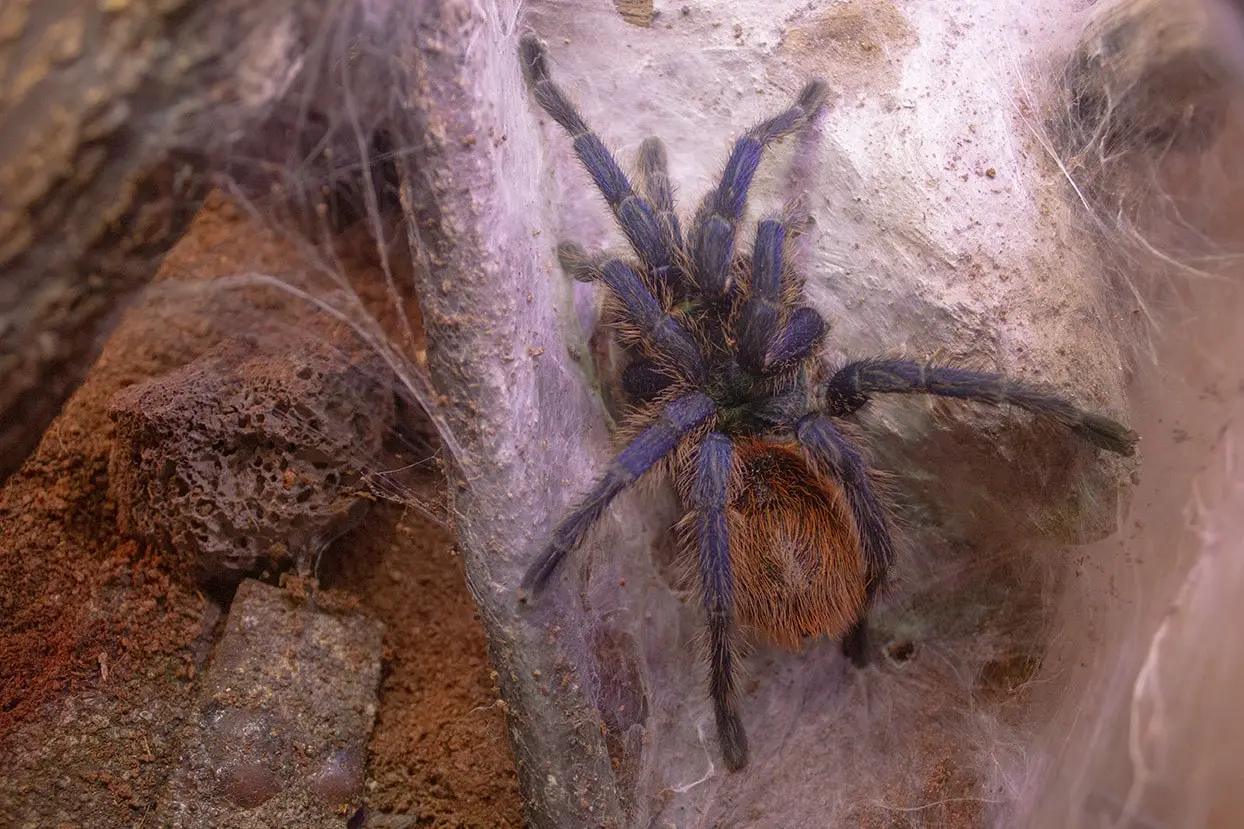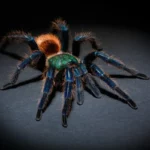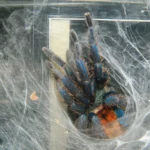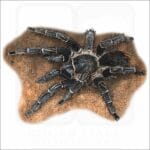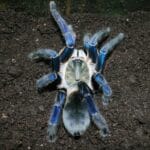Prepare to be captivated by the Green Bottle Blue Tarantula (Chromatopelma cyaneopubescens), a spider so visually stunning it seems plucked from a fantasy realm. Native to the arid landscapes of Venezuela, this tarantula, often nicknamed “GBB,” boasts a captivating fusion of vibrant blue legs and a shimmering blue-green carapace. While its beauty is undeniable, understanding its care, behavior, and habitat is crucial for properly appreciating this jewel of the arachnid world.
The Blue-Green Bottle Tarantula: A Mesmerizing Jewel of the Arachnid World
Imagine a creature draped in iridescent blue, its legs gleaming like polished metal under the desert sun – that’s the allure of the Blue-Green Bottle Tarantula. Unlike its tree-dwelling cousins, this species prefers the earth, crafting intricate burrows in the arid Paraguana Peninsula of northern Venezuela. These burrows, far from simple holes, offer respite from the heat and camouflage from predators. While their size, reaching up to 6 inches, might seem imposing, they are surprisingly docile, favoring a peaceful existence.
A Closer Look: Unveiling the Greenbottle Blue Tarantula
| Feature | Description |
|---|---|
| Size | Can reach up to 6 inches in leg span |
| Lifespan | Females can live for 10-15 years, males significantly less |
| Temperament | Generally calm, but can be skittish |
| Venom Potency | Mild, similar to a bee sting |
Don’t mistake their tranquility for weakness, though. Like all tarantulas, they possess urticating hairs on their abdomen, capable of causing irritation when flicked at threats. This defense mechanism, along with their vivid coloration, serves as a warning: admire their beauty from a respectful distance.
Intriguingly, some Blue-Green Bottle Tarantulas exhibit a rare social tolerance, allowing them to cohabitate in groups under careful observation. This fascinating behavior, combined with their relatively docile nature, makes them a popular choice for beginner tarantula enthusiasts.
Habitat and Origins: From the Paraguana Peninsula to Your Terrarium
To truly appreciate this tarantula, we must journey to its origins: the arid Paraguana Peninsula of northern Venezuela. This unique region, where desert meets grassland, provides the perfect backdrop for the Blue-Green Bottle Tarantula’s burrowing lifestyle. Unlike its tree-dwelling cousins, this species opts for a subterranean life, crafting elaborate burrows that offer protection from the elements and potential predators.
This adaptation to harsh, arid environments has led to a unique sensitivity to humidity in captivity. Maintaining a dry terrarium with proper ventilation is paramount to their well-being, mimicking their natural habitat as closely as possible.
Blue Green Bottle Tarantula Care: A Comprehensive Guide
So, you’re captivated by the allure of the Blue-Green Bottle Tarantula and considering welcoming one into your home? That’s fantastic! But before you do, let’s equip you with the knowledge to provide the best possible care for these captivating creatures.
Creating a Desert Oasis: Recreating the Ideal Habitat
- Enclosure: A spacious glass terrarium or plastic tub with ample ventilation is crucial. Remember, these tarantulas are architects at heart, and providing a thick layer of dry substrate like a blend of peat moss, vermiculite, and coconut fiber allows them to indulge in their natural burrowing instincts.
- Climate Control: Replicating the arid climate of their Venezuelan homeland is key. Maintain a warm, dry environment within the enclosure, and carefully monitor humidity levels to prevent respiratory issues. A shallow water dish provides drinking water and helps maintain humidity levels.
- Environmental Enrichment: While they may not swing from branches, providing climbing opportunities like cork bark or smooth rocks allows for exploration and exercise. Consider adding a hideaway for privacy, mimicking their natural burrows in the wild.
Dietary Delights: Fueling Your Eight-Legged Companion
- Carnivorous Cravings: True to their nature, Blue-Green Bottle Tarantulas are carnivores, their wild diet consisting of unsuspecting insects. Replicate this at home with readily available feeder insects like crickets, roaches, and the occasional mealworm. Variety is key, just like with any good menu!
- Feeding Frequency: Young, rapidly growing tarantulas benefit from more frequent feedings, sometimes several times a week. Adults, however, can be fed less frequently, once or twice a week. Observe their eating habits and adjust accordingly.
Handling and Husbandry: Approaching with Care and Respect
- Respectful Observation: While generally docile, Blue-Green Bottle Tarantulas are incredibly skittish. Sudden movements and loud noises can stress them, so prioritize observation over handling.
- Handling Techniques: If handling is necessary, approach slowly and calmly, using a gentle scooping motion to lift them from below. Never handle them directly after feeding, as this can increase stress.
- Health Monitoring: Regularly inspect your tarantula for any signs of illness, such as lethargy, loss of appetite, difficulty molting, or unusual behavior. If you notice any concerning symptoms, consult a qualified veterinarian specializing in exotic animals immediately.
What makes the green bottle blue tarantula so alluring yet intimidating? Dive into the question that might have crossed your mind – are these ethereal creatures aggressive? Are they an ideal pet for beginners? Explore these mysteries here.
Understanding Blue Green Bottle Tarantula Behavior: Beyond the Blue
Beyond their captivating appearance lies a world of fascinating behaviors. Understanding these nuances is crucial for responsible care and enriching their captive lives.
- Nocturnal Wanderers: While they may seem inactive during the day, they truly come alive at night, exploring their enclosures and seeking prey.
- Masterful Hunters: Don’t be fooled by their docile nature; they are skilled hunters, using lightning-fast reflexes to ambush their prey. Witnessing this predatory dance is a captivating reminder of their wild instincts.
- Molting Marvels: Like all tarantulas, they shed their exoskeletons as they grow. This process, while essential, can be stressful, so provide a calm, undisturbed environment during this time.
Conservation: Protecting a Dazzling Species
Sadly, the beauty of the Blue-Green Bottle Tarantula makes it a target for the illegal pet trade. Habitat loss, driven by deforestation and human encroachment, further threatens their wild populations. By choosing captive-bred tarantulas from reputable breeders and supporting conservation organizations dedicated to protecting their natural habitats, we can contribute to the preservation of this mesmerizing species for generations to come.
Caring for a Blue-Green Bottle Tarantula is a rewarding journey of discovery. By understanding their needs, respecting their boundaries, and appreciating their unique beauty, we can ensure they thrive both in our care and in the wild.
- SYBAU See You Baby Meaning: Gen Z Slang Evolves - July 1, 2025
- Unlock Your Inner Youth: Lifestyle Secrets for a Vibrant Life - July 1, 2025
- Decode SYBAU Meaning: Gen Z Slang Explained - July 1, 2025
